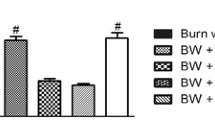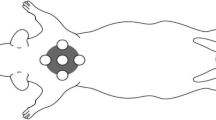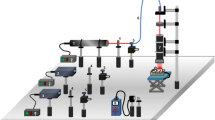Abstract
Gallium-arsenide (GaAs) and helium-neon (HeNe) lasers are the most commonly used low-energy lasers in physiotherapy for promoting wound healing and pain modulation. The aim of this study was investigate the effect of low-power laser irradiation (LPLI) at different wavelengths and doses on oxidative stress and fibrogenesis parameters in an animal model of wound healing. The animals were randomly divided into five groups (n = 6): Controls (skin injured animals without local or systemic treatment), skin injury treated with HeNe 1 J/cm2 (two seg); skin injury treated with HeNe 3 J/cm2 (six seg); skin injury treated with GaAs 1 J/cm2 (three seg); skin injury treated with GaAs 3 J/cm2 (nine seg). A single circular wound measuring 8 mm in diameter was surgically created on the back of the animal. The rats were irradiated at 2, 12, 24, 48, 72, 96, and 120 h after skin injury. The parameters, namely hydroxyproline content, activities of the antioxidant enzymes superoxide dismutase (SOD) and catalase (CAT), and lipid (TBARS) and protein oxidation (carbonyl groups) measurements were assessed. In addition, wound size regression was also analyzed. The results showed an improvement in the wound healing reflected by the reduction in wound size and increased collagen synthesis. Moreover, a significant reduction in TBARS levels, carbonyl content, and SOD and CAT activities were observed after laser irradiation, particularly with the treatments HeNe laser 1 and 3 J/cm2 dose and GaAs 3 J/cm2 dose. The data strongly indicate that LPLI therapy is efficient in accelerating the skin wound healing process after wounding, probably by reducing the inflammatory phase and inducing collagen synthesis.




Similar content being viewed by others
References
Miyata H, Genma T, Ohshima M et al (2006) Mitogen-activated protein kinase/extracellular signal-regulated protein kinase activation of cultured human dental pulp cells by low-power gallium-aluminium-arsenic laser irradiation. Int Endod J 39:238–244
Thawer HA, Houghton PE (1999) Effect of laser irradiation on the growth and development of fetal mouse limbs in an in vitro model. Lasers Surg Med 24:285–295
Conlan MJ, Rapley JW, Cobb CM (1996) Biostimulation of wound healing by low-energy laser irradiation. A review. J Clin Periodontol 23:492–496
Nascimento PM, Pinheiro AL, Salgado MA, Ramalho LM (2004) A preliminary report on the effect of laser therapy on the healing of cutaneous surgical wounds as a consequence of an inversely proportional relationship between wavelength and intensity: histological study in rats. Photomed Laser Surg 22:513–518
Pessoa ES, Melhado RM, Theodoro LH, Garcia VG (2004) A histologic assessment of the influence of low-intensity laser therapy on wound healing in steroid-treated animals. Photomed Laser Surg 22:199–204
Pinheiro AL, Meireles GC, Barros-Vieira AL, Almeida D, Carvalho CM, Santos JN (2004) Phototherapy improves healing of cutaneous wounds in nourished and undernourished Wistar rats. Braz Dent J 15:21–28
Silveira PCL, Streck EL, Pinho RA (2007) Evaluation of mitochondrial respiratory chain activity in wound healing by low-level laser therapy. Photochem Photobio 86:279–282
Karu T, Pyatibrat L, Kalendo G (1995) Irradiation with He-Ne laser increases ATP level in cells cultivated in vitro. J Photochem Photobiol B: Biol 27:219–223
Silveira PCL, Silva LA, Fraga DB et al (2009) Evaluation of mitochondrial respiratory chain activity in muscle healing by low-level laser therapy. Photochem Photobiol 95:89–92
Serarslan G, Altug E, Kontas T, Atik E, Avci G (2007) Caffeic acid phenethyl ester accelerates cutaneous wound healing in a rat model and decreases oxidative stress. Clin Exp Dermatol 32:709–715
Phan T, Wang L, See P (2001) Phenolic compounds of Chromolaena odorata protect cultured skin cells from oxidative damage: implication for cutaneous wound healing. Biol Pharm Bull 24:1373–1379
Juránek I, Bezek S (2005) Controversy of free radical hypothesis: reactive oxygen species—cause or consequence of tissue injury? Gen Physiol Biophys 24:263–278
Carvalho PTC, Mazzer N, Reis FA (2006) Analysis of the influence of low-power HeNe laser on the healing of skin wounds in diabetic and non-diabetic rats. Acta Cir Brás 21:177–183
Morrone ET (1998) Muscular trauma treated with a Ga–Al–As diode laser: in vivo experimental study. Lasers Med Sci 13:293–298
Woessner JF (1961) The determination of hydroxyproline in tissue and protein samples containing small proportions of this amino acid. Arch Biochem Biophys 93:440–447
Draper HH, Hadley M (1990) Malondialdehyde determination as index of lipid peroxidation. Meth Enzymol 186:421–431
Levine RL, Garland D, Oliver CN (1990) Determination of carbonyl content in oxidatively modified proteins. Meth Enzymol 186:464–478
Bannister JV, Calabrese L (1987) Assays for SOD. Meth Biochem Anal 32:279–312
Aebi H (1984) Catalase in vitro. Meth Enzymol 105:121–126
Lowry OH, Rosebough NG, Farr AL (1951) Protein measurement with the folin phenol reagent. J Biol Chem 193:265–275
Li G, Feng X, Wang S (2005) Effects of Cu/Zn superoxide dismutase on strain injury-induced oxidative damage to skeletal muscle in rats. Physiol Res 54:193–1999
Pereira LM, Hatanaka E, Martins EF et al (2008) Effect of oleic and linoleic acids on the inflammatory phase of wound healing in rats. Cell Biochem Funct 26:197–204
Henry G, Warren L, Garner MD (2003) Inflammatory mediators in wound healing. Surg Clin N Am 83:483–507
Pattwell DM, Jackson MJ (2004) Contraction-induced oxidants as mediators of adaptation and damage in skeletal muscle. Exerc Sport Sci Rev 32:14–18
Sommer AP, Pinheiro ALB, Mester AR et al (2001) Biostimulatory windows in low intensity laser activation: lasers, scanners and NASA’s light-emitting diode array system. J Clin Laser Med Surg 19:29–34
Karu T (1999) Primary and secondary mechanisms of action of visible to near-IR radiation on cells. J Photochem Photobiol B: Biol 49:1–17
Vekshin NL, Mironov GP (1982) Flavin-dependent oxygen uptake in mitochondria under illumination. Biofizika 27:537–539
Passarella S, Casamassima F, Molinari S et al (1984) Increase of proton electrochemical potential and ATP synthesis in rat liver mitochondria irradiated in vitro by He-Ne laser. FEBS Lett 175:95–99
Karu T (1987) Photobiological fundamentals of low-power laser therapy. IEEE J Quantum Electron 23:1703–1717
Beauvoit B, Kitai T, Chance B (1994) Contribution of the mitochondrial compartment to the optical properties of the rat liver: a theoretical and practical approach. Biophys J 67:2501–2510
Cooper CE, Springett R (1997) Measurement of cytochrome oxidase and mitochondrial energetics by near-infrared spectroscopy. Philos Trans R Soc Lond B Biol Sci 352:669–676
Byrnes KR, Barna L, Chenault VM et al (2004) Photobiomodulation improves cutaneous wound healing in an animal model of type II diabetes. Photomed Laser Surg 22:281–290
Poli G, Parola M (1997) Oxidative damage and fibrogenesis. Free Radic Biol Med 22:287
Fukushima K, Badlani N, Usas A et al (2001) The use of antifibrosis agent to improve muscle recovery after laceration. Am J Sports Med 29:394
Reddy GK, Stehno-Bittel L, Enwemeka CS (1998) Laser photostimulation of collagen production in healing rabbit Achilles tendons. Lasers Surg Med 22:281–287
Stadler I, Lanzafame RJ, Evans R et al (2001) 830-nm irradiation increases the wound tensile strength in a diabetic murine model. Lasers Surg Med 28:220–226
Al-Watban F, Andres B (2003) Polychromatic LED therapy in burn healing of non-diabetic and diabetic rats. J Clin Laser Med Surg 21:249–258
Gillitzer R, Goebeler M (2001) Chemokines in cutaneous wound healing. J Leukoc Biol 69:513–521
Ruszczak Z, Schwartz R (2000) Modern aspects of wound healing: an update. Dermatol Surg 26:219–229
Kerkweg U, Petrat F, Korth HG (2007) Disruption of skeletal myocytes initiates superoxide release: contribution of NAD(P)H oxidase. Shock 27:552–558
Albertini R, Villaverde AB, Aimbire F (2007) Anti-inflammatory effects of low-level laser therapy (LLLT) with two different red wavelengths (660 nm and 684 nm) in carrageenan-induced rat paw edema. J Photochem Photobiol B: Biol 89:50–55
Liu X, Zhou Y, Liu TC (2009) Effects of low-level laser irradiation on rat skeletal muscle injury after eccentric exercise. Photomed Laser Surg 27:863–869
Halliwell B, Gutteridge JMC (2007) Free Radical in Biology Medicine. University Press, Oxford, NY
Musalmah M, Fairuz AH, Gapor MT et al (2002) Effect of vitamin E on plasma malondialdehyde, antioxidant enzyme levels and the rates of wound closures during wound healing in normal and diabetic rats. Asia Pacific J Clin Nurt 11:448–451
Shukla A, Rasik AM, Patnaik GK (1997) Depletion of reduced glutathione, ascorbic acid, vitamin E and antioxidant defence enzymes in a healing cutaneous wound. Free Radic Res 26:93–101
Author information
Authors and Affiliations
Corresponding author
Rights and permissions
About this article
Cite this article
Silveira, P.C.L., Silva, L.A., Freitas, T.P. et al. Effects of low-power laser irradiation (LPLI) at different wavelengths and doses on oxidative stress and fibrogenesis parameters in an animal model of wound healing. Lasers Med Sci 26, 125–131 (2011). https://doi.org/10.1007/s10103-010-0839-0
Received:
Accepted:
Published:
Issue Date:
DOI: https://doi.org/10.1007/s10103-010-0839-0




